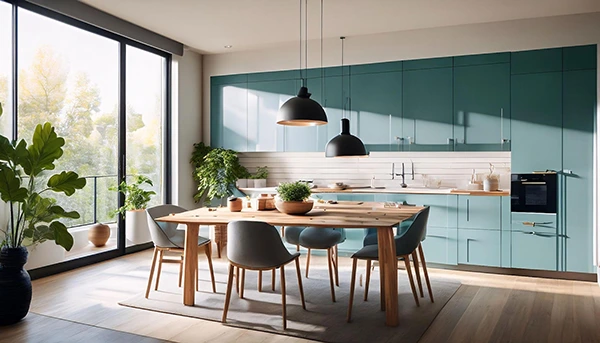
Designing a biophilic kitchen is not just about adding plants or selecting organic textures. It involves thoughtfully planning how light, space, and natural materials come together to create a kitchen that feels balanced and connected to nature.
Additionally, modern biophilic design in the kitchen is not confined to one style. The versatile nature of biophilic design provides homeowners with the flexibility to experiment with different layouts, finishes, and natural accents while still maintaining a strong connection to nature.
In this blog, we’ll explore what biophilic kitchen design truly means, the essential elements that bring it to life, and the lasting benefits it can offer homeowners.
What is Biophilic Kitchen Design?
The term biophilic is derived from two Greek roots: bios, meaning life, and philia, meaning love or affection. Combined, they translate to “love of life” or “love of living things,” which makes the foundation of biophilic interior design.
This philosophy serves as the foundation of biophilic interior design. Within the kitchen, biophilic interior design emphasizes the use of natural elements to cultivate a healthier, more inspiring space. A biophilic kitchen design transforms the act of cooking and gathering into experiences deeply connected with nature. In the midst of modern urban living, adopting biophilic style in the kitchen offers a refreshing balance and a renewed sense of harmony at home.
Essential Components of a Sustainable Biophilic Kitchen
While biophilic kitchen design is rooted in sustainability and nature, it extends beyond those principles. Creating a true biophilic space in your kitchen means thoughtfully blending eco-conscious materials, natural elements, and smart solutions that enhance daily living. Below are some key components to consider when planning a biophilic style kitchen.
- Natural and Recycled Materials: Building a sustainable biophilic kitchen begins with eco-friendly choices such as FSC-certified wood, bamboo, reclaimed stone, and recycled glass. Each material plays a distinct role: wood and bamboo infuse warmth and organic texture into flooring and cabinetry, reclaimed stone ensures durability, and recycled glass introduces colour and sparkle to backsplashes and countertops.
- Energy and Water Efficiency: Prioritizing energy and water efficiency is essential in a sustainable biophilic kitchen. Installing energy-efficient appliances ensures reliable performance with lower energy demand, and low-flow faucets keep water use under control without sacrificing convenience. Integrating smart lighting systems also supports efficiency by adjusting brightness according to the time of day and available sunlight, so you can maximize natural daylight.
- Sustainable Finishes and Treatments: While this element of kitchen design is overlooked, paying attention to how materials are treated is essential for creating a healthy environment. Sustainable finishes such as plant-based oils, breathable plasters, and low-VOC sealants preserve the natural integrity of wood, stone, and other surfaces while supporting better indoor air quality and long-term sustainability.
- Air-Purifying Plants and Vertical Gardens: Greenery plays a functional role in biophilic kitchen design. Beyond their decorative appeal, plants absorb toxins, improve oxygen levels, and stabilize indoor humidity, creating a healthier atmosphere for cooking and gathering. Meanwhile, vertical gardens and built-in herb planters maximize space efficiency and offer convenient access to fresh ingredients.
- Smart Integration of Technology with Nature: In addition to incorporating recycled materials and plants, integrating smart systems into your kitchen also enhances efficiency and sustainability. Smart appliances, daylight-responsive lighting, and self-watering planters simplify maintenance while ensuring that natural features remain functional and durable.
Design resources such as Kitchen & More highlight real-world projects that show how biophilic kitchen design can turn an ordinary kitchen into a vibrant, wellness-oriented environment, particularly for homeowners considering a remodel in Bellevue.
The Benefits of Bringing Biophilic Design Interior into Your Kitchen
Opting for a biophilic style kitchen offers significant benefits for homeowners seeking a healthier, more sustainable way of living. Here are some key advantages that show why integrating nature into the kitchen has become such an influential design trend.
- Healthier Living Environment: Incorporating plants, natural ventilation, and non-toxic finishes creates cleaner indoor air and a safer environment for cooking and gathering.
- Emotional Balance: Natural light, greenery, and organic finishes influence mood in subtle yet powerful ways. By weaving these elements into the design, the kitchen becomes a grounding space where family members can recharge and reconnect.
- Timeless Aesthetic Appeal: Unlike fleeting design trends, biophilic kitchens remain stylish year after year. Natural surfaces and textures develop character over time, ensuring the space grows more beautiful and functional with age.
- Increased Home Value: Interested home buyers are now increasingly prioritizing homes designed with sustainability and well-being in mind. Kitchens that combine eco-friendly materials with a wellness-focused layout stand out in the market, adding both lifestyle value and long-term investment potential.
Key Takeaways
A biophilic kitchen represents a shift in how design is approached. Unlike passing trends, these design choices are rooted in timeless principles that ensure your kitchen will remain inviting, functional, and aligned with a sustainable lifestyle for years to come.
At the same time, the growing demand for wellness-oriented spaces means that biophilic kitchens carry strong market appeal, offering a competitive edge when it comes to reselling homes. Homeowners who embrace this approach are not just following a design movement but are reshaping how the most central room of the home contributes to everyday life.






